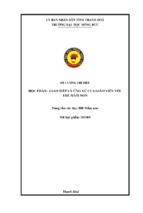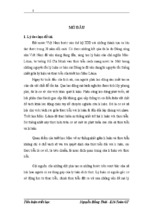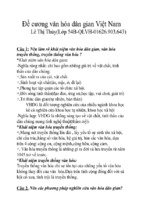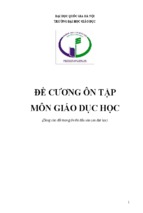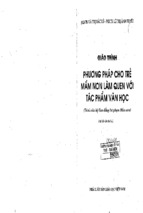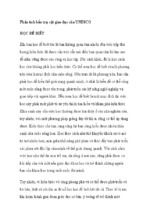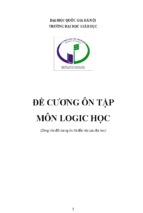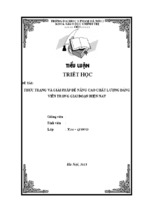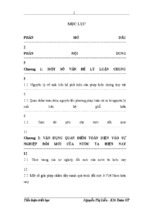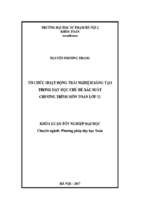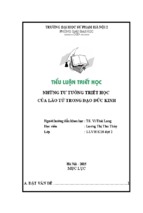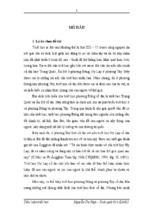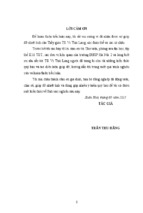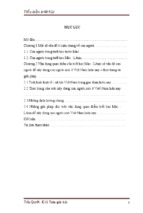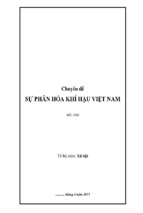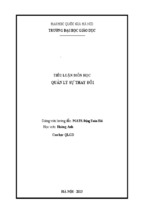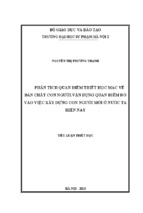THAI NGUYEN UNIVERSITY
SCHOOL OF FOREIGN LANGUAGES
LE THI HONG CHUYEN
AN INVESTIGATION INTO USING COMMUNICTIVE
ACTIVITIES IN TEACHING ENGLISH SPEAKING SKILL
AT HIGH SCHOOLS IN BAC NINH PROVINCE
M.A THESIS
Field: English Linguistics
Code: 8220201
THAI NGUYEN - 2020
ĐẠI HỌC THÁI NGUYÊN
TRƯỜNG NGOẠI NGỮ
LÊ THỊ HỒNG CHUYÊN
ĐIỀU TRA VỀ VIỆC SỬ DỤNG CÁC HOẠT ĐỘNG
GIAO TIẾP TRONG VIỆC DẠY KĨ NĂNG NÓI TIẾNG ANH
Ở CÁC TRƯỜNG THPT TẠI TỈNH BẮC NINH
LUẬN VĂN THẠC SĨ
Ngành: Ngôn ngữ Anh
Mã số: 8220201
THÁI NGUYÊN - 2020
DECLARATION
I confirm that the thesis entitled “An investigation into using communicative
activities in teaching English speaking skill at high schools in Bac Ninh province” is
the result of my own study in the fulfillment of the requirement for the Degree of Master
at School of Foreign Languages, Thai Nguyen university. I commit that this thesis has
not been submitted anywhere for any degree or qualification.
Thai Nguyen, 2020
Approved by Supervisor
Student
Dr. Nguyen Thi Thu Hoai
Le Thi Hong Chuyen
i
ACKNOWLEDGMENTS
Firstly, I would like to thank my supervisor, Dr. Nguyen Thi Thu Hoai for
giving me support, guideline and feedback when I carried out my study.
Secondly, I would like to thank all of teachers at School of Foreign Languages in
Thai Nguyen University who provided me with necessary help as well as good
suggestions whenever I got into trouble.
Thirdly, I would also like to send my special thanks to ten grade 10th English
teachers and a lot of students at Yen Phong number 1 and Yen Phong number 2
High School who helped me carry out the research.
Last but not least, I would like to extend my gratefulness to my family, my
friends and many others who continuously offer spiritual support and
encouragement during the process of doing this study.
Bac Ninh, October 24th 2020
Student
Le Thi Hong Chuyen
ii
ABSTRACT
Communicative activities play important role in teaching and learning English
because they have the notability to encourage students‟ participation and help students
improve their speaking skills and practice them for real-life situations. Actually, what
teachers and students think about these activities and what difficulties teachers and
students may have when applying these activities. The study was done for the purpose
of finding out the answers to these questions. The reality of teaching and learning
English speaking with communicative activities of grade 10th at High schools in Bac
Ninh was made clear. The data of research was collected by three research instruments
that are questionnaires, class observation and interviews. The results showed that both
teachers and students found a lot of benefit from using communicative activities.
However, some difficulties in the application of communicative activities at two high
schools were also realized. Last but not least, some solutions for the problem also were
suggested in the study.
iii
TABLE OF CONTENTS
DECLARATION ......................................................................................................... i
ACKNOWLEDGMENTS...........................................................................................ii
ABSTRACT .............................................................................................................. iii
TABLE OF CONTENTS ........................................................................................... iv
LIST OF TABLES ..................................................................................................... vi
LIST OF CHARTS ...................................................................................................vii
CHAPTER 1. INTRODUCTION ............................................................................ 1
1.1. Rationale .............................................................................................................. 1
1.2. Aims of the study ................................................................................................. 3
1.3. Scope of the study ................................................................................................ 3
1.4. Organization of the thesis..................................................................................... 4
CHAPTER 2. LITERATURE REVIEW ................................................................ 5
2.1. English speaking skill .......................................................................................... 5
2.1.1. Definition of speaking skill ........................................................................ 5
2.1.2. The importance of speaking skill ............................................................... 6
2.1.3. A speaking lesson ....................................................................................... 7
2.2. Communicative Language Teaching ................................................................... 9
2.2.1. Definition of Communicative Language Teaching .................................... 9
2.2.2. The Characteristics of Communicative Language Teaching ..................... 9
2.2.3. The Goal of Communicative Language Teaching ................................... 10
2.3. Communicative activities ................................................................................... 11
2.3.1. Definition of communicative activities .................................................... 11
2.3.2. Features of communicative activities ....................................................... 11
2.3.3. The significance of communicative activities in speaking lessons .......... 13
2.3.4. Factors for applying communicative activities successfully in speaking
lessons ................................................................................................................ 14
2.3.5. Types of communicative activities ................................................................. 16
2.4. Related Studies ................................................................................................... 18
iv
CHAPTER 3. METHODOLOGY ......................................................................... 20
3.1. Method of the study ........................................................................................... 20
3.2. Participants ......................................................................................................... 20
3.3. Research procedure ............................................................................................ 20
3.4. Data collection instruments ................................................................................ 21
3.4.1. Questionnaires .......................................................................................... 21
3.4.2. Observation ............................................................................................... 22
3.4.3. Interview ................................................................................................... 22
3.5. Data analytical method ....................................................................................... 22
CHAPTER 4. FINDINGS AND DISCUSSIONS ................................................. 23
4.1. Data analysis ...................................................................................................... 23
4.1.1. Result from teachers‟ questionnaires ........................................................ 23
4.1.2. Result from students‟ questionnaire ......................................................... 28
4.1.3. Result from class observation ................................................................... 34
4.1.4. Result from interview ............................................................................... 36
4.2. Discussions ......................................................................................................... 38
4.2.1. Types of communicative activities used in speaking lessons:.................. 38
4.2.2. Attitudes of both Teachers and Students toward communicative activities: ........ 38
4.2.3. Difficulties in applying communicative activities: ................................... 39
4.3. Suggested solutions ............................................................................................ 41
CHAPTER 5. CONCLUSION ............................................................................... 43
5.1. Conclusion.......................................................................................................... 43
5.2. Suggested for further research ........................................................................... 43
5.3. Limitations of the study ..................................................................................... 44
REFERENCES .......................................................................................................... 45
APPENDICES............................................................................................................. I
APPENDIX 1: QUESTIONNAIRES ......................................................................... I
QUESTIONNAIRES FOR TEACHERS .................................................................... I
APPENDIX 2: CLASS OBSERVATION ............................................................. VIII
APPENDIX 3: INTERVIEW. ...................................................................................XI
v
LIST OF TABLES
Table 4.1.
The reasons for choosing the most effective activities ....................... 24
Table 4.2:
The frequency of using types of class arrangement ............................ 25
Table 4.3:
Techniques teachers use to overcome difficulties in speaking lessons............... 27
Table 4.4:
Students‟ favorite communicative activities and class arrangement ......... 31
vi
LIST OF CHARTS
Chart 4.1:
Teachers‟ reflection about using communicative activities .............. 23
Chart 4.2:
Difficulties in using communicative activities in speaking lessons ...... 25
Chart 4.3:
Teachers‟ solution to help students complete the speaking task ....... 26
Chart 4.4:
Students‟ attitude toward speaking lessons ....................................... 28
Chart 4.5:
Using Vietnamese in speaking lessons .............................................. 29
Chart 4.6:
Students‟ reason for their interest in speaking lessons. ..................... 30
Chart 4.7:
Teachers‟ frequency of using communicative activities ................... 31
Chart 4.8:
Students‟ attitudes toward communicative activities ........................ 32
vii
CHAPTER 1. INTRODUCTION
1.1. Rationale
It can‟t be denied that English is one of the most widely used languages in the
world. Therefore, it is really important for everyone to master English. This is also
the purpose of people who are learning English as a foreign language. The
widespread use of English leads to a surprising increase of English learners nowadays,
especially learners in Asian countries in general and Vietnam in particular. In high
schools, learning English becomes more important for students since it is one of three
compulsory subjects in General Certificate of Secondary Education examination.
Moreover, Vietnamese students study English as a preparation for their future jobs
that usually require the ability of speaking English.
Although English is taught from Primary to High School many High School
graduates are in low level to practice English skills, especially speaking skill. It is
believed that there are several reasons causing the students‟ difficulties in speaking.
Some of the reasons are due to the old teaching methods which were less effective. In
previous years the methodology was teacher-centered and focused only on reading and
writing. Grammar was considered as primary importance and was often taught most
thoroughly. This also caused a common problem: The Grammar -Translation method
was mainly used. Teachers usually taught grammar rather than other skills. Moreover,
most of the activities were of the traditional modes, such as reading the dialogues,
reciting texts and doing written exercises. There were few examinations which have
oral tests, which caused both the teachers and students to neglect oral skill.
That is the reason why students are not able to use English they have learnt
for a long time for the purpose of communication. They cannot speak English even
in a daily conversation, so they obviously find it difficult to use English in a
communicative environment in their future jobs. The reality requires that high
school English teachers need to pay more attention to students‟ speaking skill. It is
better for students if teachers apply Communicative Language Teaching in the
classroom. To achieve the goals of learning English, communicative activities in
1
English classes are very necessary. It seems to be easy for teachers to apply some
communicative activities in speaking lessons which always deal with an important
characteristic “learners talk a lot” (Brown, 2001).
Actually, all teachers of English at my school-Yen Phong number 1 High
School have applied communicative activities in teaching four skills: listening,
speaking, reading and writing. By using some typical types of communicative
activities such as group work, role play or discussion, teachers really draw students‟
participation in speaking activities. However, it is denied that teachers often face
some challenges when they organize the communicative activities in speaking
classes. The first challenge is that the number of students in one class is big (about
45 students) with different cognitive abilities, which leads to the fact that many
students can‟t take part in all speaking activities. Secondly, all previous examinations
still only focused on grammar and vocabulary. It is the reason why students don‟t
spend much time practicing speaking skill.
To overcome the second challenge, High schools in Bac Ninh province in
general, my school in particular has used the new English text book by the Ministry
of Education for two years. The new text book focuses mainly on communication
skills. Moreover, all tests and examinations are required to have listening skills and
after each term students must take part in speaking tests. Therefore, students must
spend more time practicing speaking English than before. In addition, each unit
includes a project part at the end of the last lesson. This part requires students work
in groups to do surveys on one topic at home and present it in front of the whole
class after that. Consequently, students improve their speaking skill a lot. Thus,
most of the grade tenth students at my school feel eager to practice speaking in both
speaking lesson and project part. However, teachers still can‟t avoid the fact that
each class has a lot of students with different levels. Obviously, there are some
students that can‟t take part in communicative activities and understand the lesson
as well. Furthermore, the knowledge in the new text book is relatively difficult with
a lot of new words and each period has many activities. Teachers can hardly
2
complete all activities in a forty five minute period. In reality, the cognitive ability
of students of different classes are not the same, so teachers need to use types of
communicative activities in speaking lessons flexibly.
Such problems mentioned above lead to the essential of the thesis: An
investigation into using communicative activities in teaching English speaking skills at
high schools in Bac Ninh province. The study is done for collecting data of the real
practice of using the activities in speaking classes at some high schools in Bac Ninh
province and suggesting solutions for teachers to help their students learn English better.
1.2. Aims of the study
The study aims to:
- Realize the reality of applying communicative activities in teaching English
speaking skill of grade tenth students at two schools at Bac Ninh Province that are
Yen Phong number 1 High School and Yen Phong number 2 High School in terms
of types of communicative activities and the opinions of both teacher and students
about these activities.
- Find out some solutions for difficulties in the teaching and learning process.
- Suggest some implications for practicing communicative activities.
Based on the background of the research, the research problems will answer
the following questions about teaching, learning and applying communicative
activities in speaking lessons.
1. What types of communicative activities are used in speaking lessons?
2. What are the attitudes of both Teachers and Students toward communicative
activities?
3. What are difficulties in applying communicative activities?
1.3. Scope of the study
The scope of the research is limited to a survey on the real situation of using
communicative activities in teaching English speaking skills for grade tenth
students at two high schools in Bac Ninh province that are Yen Phong number 1
High School and Yen Phong number 2 High School. Therefore, the researcher tries
to realize what types of communicative activities are used in teaching English
3
speaking skills for grade tenth students at two High Schools in BacNinh province as
well as the opinions of teachers and students about applying communicative
activities in speaking lessons.
1.4. Organization of the thesis
The graduation thesis consists of five chapters, organized as follows:
Chapter 1. Introduction. This chapter mentions the background and rationale to
conduct the study, states the aims, the significances, the scope, and organization of
the graduation thesis.
Chapter 2. Literature Review. This chapter represents theoretical background
knowledge related to speaking skill, and a brief review of the previous studies on
communicative activities and its impacts on students‟ speaking ability.
Chapter 3. Methodology. This chapter states the subjects of the study,
research instruments, and data collection procedures employed in this research.
Chapter 4. Findings and Discussions. This chapter analyzes and discusses
the results collected from survey questionnaire, class observation and interview.
Besides, the limitations of the study are introduced.
Chapter 5. Conclusions and Recommendations. This chapter summarizes
the main points discussed in the previous parts, presents the limitations of the thesis
and provides some suggestions for further research.
4
CHAPTER 2. LITERATURE REVIEW
This chapter provides the theoretical foundations and the previous studies on
the use of communicative activities of students in English speaking skill. It consists
of four parts. Firstly, it discusses English speaking skill including definition and the
role of English speaking skill in real life as well as some characteristics of a
successful speaking lesson. Secondly, it mentions the principles of Communicative
Language Teaching with its definition, characteristics and goal. Thirdly, it
conceptualizes communicative activities in terms of definition, significance, factors
for successful communicative activities and types of communicative activities. In
the last section, some previous studies in the application of communicative
activities in speaking lessons are presented.
2.1. English speaking skill
2.1.1. Definition of speaking skill
Speaking is considered as the most important one among four skills of
learning English due to the purpose of language communication. Oxford dictionary
defines “Speaking is the action of conveying information or expressing one‟s
feelings in speech”. Another definition is that speaking is "the process of building
and sharing meaning through the use of verbal and non-verbal symbols, in a variety
of contexts" (Chaney, 1998). Speaking is an important part of second language
learning and teaching.
In particular, English speaking skill is defined in different ways. “Speaking is
a productive skill in the oral mode. It is like the other skills, is more complicated
than it seems at the first and involves more than just pronouncing words.”(Azem,
M. & Dogar, M.H., 2011). Hornby (1995) defines that speaking is the skill that the
students will be judged upon most in real-life situations. It focuses on everyday
interaction and the speaking ability of fluency and comprehension. In addition,
“Speaking is one of the skills that have to be mastered by students in learning
English. Speaking is an essential tool for communicating”(Grognet A.G, 1997).
5
Speaking skill consists of two major categories -accuracy, involving the
correct use of vocabulary, grammar and pronunciation practiced through controlled
and guided activities; and fluency considered to be “the ability to keep going when
speaking spontaneously” (Harmer, 2001). Bryne, D. (1986) additionally declares
that accuracy refers to the use of correct forms where utterances do not contain
errors affecting the phonological, syntactic and semantic or discourse features of a
language; fluency may be known as the ability to keep on speaking without too
much hesitation and too many pauses to cause a breakdown in communication. In
this case, instant correction shouldn‟t be used since it could interfere with the
process of communication.
2.1.2. The importance of speaking skill
Among the four skills taught at school, speaking is the most difficult skill to
build in the classroom, whereas, as Thornbury ( 2005: 1) says, speaking is so much
a part of daily life that we take it for granted.
Communication involves speech where learners are expected to interact
verbally with other people. Moreover, the teacher doesn‟t need to talk a lot, which
means that learners are supported to talk more in the classroom.
Today, many second language learners give the speaking skill priority in
their learning because if they master this skill then they will be considered as if they
have mastered all of the other skills. Furthermore, the main question often given to
foreign language learners is "do you speak English?” Or "do you speak French?”
but not "do you write English?” We understand that most of people take speaking
and knowing a language as synonyms. The importance of speaking is more revealed
with the integration of the other language skills. For instance, speaking can help
students to develop their vocabulary and grammar and then improving their writing
skill. With speaking, learners can express their personal feeling, opinions or ideas;
tell stories; inform or explain; request; converse and discuss, i.e. through speaking,
we can display the different functions of language.
Speaking is really important, since it is the most useful skill when someone
wants to convey messages and exchange information. Richards (2008: 19) states
that the mastery of speaking skill in English is a priority for many second6
language or foreign-language learners. Moreover, many companies and organizations
look for people who speak English very well for the purpose of communicating
with other people. So, speakers of foreign languages have more opportunities to
get jobs in such companies. Baker and Westrup (2003) supported that “a student
who can speak English well may have a greater chance for further education or
finding employment”.
2.1.3. A speaking lesson
A speaking lesson can be understood as all the activities that the teacher
designed to help students apply the new language that they have learned in real
situations outside the classroom.
2.1.3.1. Characteristics of a successful speaking lesson/ activity:
- Learners are centered. It means that learners should speak for most of the
lesson/ activity.
- Learners‟ participation is equal. The teacher should organize activities
involving students to work in groups so that all members of these groups can
participate in the lesson/ activity equally not just excellent students
- Motivation is appreciated. Learners feel like the topic and they want to take
part in the lesson/ activity. Therefore, they are eager to speak for the whole lesson.
- Language is suitable. Learners‟ language should be at an acceptable level of
language accuracy so that their classmates can understand the discussion easily.
- Teacher‟ role is monitoring and giving suggestions. The teacher just should
walk around and monitor students‟ conversations. He/she can give some suggestions if
the tasks are difficult for learners. Finally, the teacher will give feedback to students
after their speaking.
2.1.3.2. Stages of a speaking lesson
There are three main stages in a speaking lesson: pre-speaking, whilespeaking and post - speaking. The time for the first stage and the last stage is
similarly about seven or eight minutes meanwhile the time for the second stage
(while - speaking) is about thirty minutes, which gives students enough time for
practicing speaking skills.
7
- Pre-speaking stage (Presentation stage)
At this stage, some activities designed for learners to brainstorm the topic.
These activities help students to come up with the topic of the lessons and vocabulary
preparation as well.
- While-speaking stage (Practice stage)
This stage takes about thirty minutes because it is the time for learners to
speak. The teacher will let students work individually, in pairs or in groups to
ensure that all students can participate in speaking activities equally.
Communicative activities are truly essential to be applied in this stage for the
purpose of helping students practice speaking skill. They can be a role play, a game
or a discussion. Depending on the lesson and the classroom condition, the teacher
will choose and set up the suitable activities for students.
- Post-speaking stage (Personalization stage)
It takes about seven or eight minutes to complete this stage. After practicing
speaking skill in the whole stage, students may do an extension activity in this
stage. The post task is usually “an information transfer”, a production type of
exercise where they respond to what they have just learnt.
2.1.3.3. Some implications for teaching a speaking lesson:
There is a fact that many students feel unconfident to speak English in front
of their classmates because they are afraid of making mistakes. They may want to
avoid teacher‟s comments or corrections, so they are not interested in participating
in speaking activities. To help students to overcome their own hesitation, the
teacher should design various tasks to improve students‟ motivation as Ur (1991)
declares that “motivation is very strongly related to achievement in language
learning”. Actually, there are some clear suggestions for the teacher.
- Creating a relaxing atmosphere in class. The teacher lets students work
in pairs or group so that they can speak English confidently. They are not afraid
of speaking in front of the rest of the class and they are eager to involve in all
speaking activities.
- Exposing students to naturally pronounced speech. The more natural speech
they hear, the more effective their learning speaking.
8
- Combining listening skill and speaking skill in organizing activities in the
class. The natural interaction between two skills can help students to be able to
listen and speak more easily in other real situations outside the classroom.
2.2. Communicative Language Teaching
2.2.1. Definition of Communicative Language Teaching
Communicative Language Teaching is a set of principles about the goals of
language teaching, how learners learn a language, the kinds of classroom activities
that best facilitate the learning and roles of the teachers and learners in the classroom
(Richards, 2006:2). Harmer (2001:84) adds that communicative language teaching is
a set of beliefs which includes not only re-examination of what aspects of language to
teach that stresses the significance of language functions, but also a shift in emphasis
in how to teach that is related to the idea that language learning will take care of itself
and that plentiful exposure to language in use and plentiful opportunities to use it are
vitally important to students„ development of knowledge and skills.
As (Brown 2001:46) Communicative Language Teaching tends to be learnercentered rather than teacher-centered. It requires the students to acknowledge the
language forms, meaning, and functions of the language. It leads students to
communicate in meaningful ways in certain situations.
2.2.2. The Characteristics of Communicative Language Teaching
Brown (2001:43) suggests the six interconnected characteristics of
Communicative Language Teaching.
They are described as follows:
1) Classroom goals are focused on all the components (grammatical,
discourse, functional, sociolinguistic, and strategic) of communicative competence.
2) Language techniques are designed to engage learners in the pragmatic,
authentic, functional use of language for meaningful purposes. Organizational forms
are not the central focus, but rather aspects of language that enable the learners to
accomplish those purposes.
3) Fluency and accuracy are seen as complementary principles underlying
communicative techniques. At times fluency may have to take on more importance
than accuracy in order to keep learners meaningfully engaged in language use.
9
4) Students in a communicative class ultimately have to use the language,
productively and respectively, in unrehearsed context outside the classroom. Classroom
tasks must therefore equip the students with the skills necessary for communication in
those contexts.
5) Students are given opportunities to focus on their own learning process through
an understanding on their own styles of leaning and through the development of
appropriate strategies for autonomous learning.
6) The role of the teacher is that of facilitator and guide, not an all knowing best
owner of knowledge. Students are therefore encouraged to construct meaning through
genuine linguistic meaning through genuine linguistic interaction with others.
The characteristics above indicate that the purpose of learning the language in
Communicative Language Teaching is to gain all components of language by engaging
students in meaningful communication. Communicative Language Teaching also sees
fluency as important as accuracy. Therefore, the teacher needs to balance the
activities which focus on both fluency and accuracy. The teacher should also
provide classroom activities with many opportunities to use the language through
appropriate strategies and autonomous learning. Students are considered to be the
center of the class by guidance from the teacher.
2.2.3. The Goal of Communicative Language Teaching
Richards (2006:3) also states that communicative competence includes the
following aspects of language knowledge as follows:
(1) knowing how to use language for a range of different purposes and
functions.
(2) knowing how to vary our use of language according to the setting and
participants.
(3) knowing how to produce and understand different types of texts.
(4) knowing how to maintain communication despite having limitation in
one„s language knowledge. It means that to reach communicative competence,
students need to know how to use the language according to its purposes and
functions in many different situations.
10
Brown (2001:69) states that the communicative competence is the goal of a
language classroom which can be achieved by giving attention to language use and
not just usage, to fluency not just accuracy, to authentic language and context, and
students„ eventual need to apply classroom learning to previously unrehearsed
contexts in the real world. It implies that students need to acquire communicative
competence so that the can us the language accurately, appropriately and effectively.
Celce Murcia et.al. (1995:10) divides communicative competence into discourse
competence, linguistic competence, sociocultural competence, active competence and
strategic competence.
2.3. Communicative activities
2.3.1. Definition of communicative activities
Communicative activities include some activities that engage the learners
where their main purpose of the activities is to motivate communication
(Littlewood, 2002:16). Harmer (2001:85) also states that communicative activities
can encourage students to be involved in real or realistic communication.
Therefore, the key element is that the activity is based on an authentic situation.
Communicative activities refers to the classroom activities that provide a genuine
information gap and make it possible for language learners to communicate with
target language in Communicative Language Teaching Approaches (Liao, 2000).
In other words, communicative activities are activities that give students both a desire
to communicate and a purpose which involves them in a varied use of language.
Communicative activities are also defined that they are fluency-based activities
(Tait,S.,2001). It means that these activities help students speak English fluently
rather than correctly.
2.3.2. Features of communicative activities
Savignon (2001) claims that “the problem at present is that some of the activities
being introduced as communicative activities are not communicative at all but structure
drills in disguise”. Actually, many teachers may think that the activities they design and
use in class are communicative, but actually they are not. Therefore, the features that
make a real communicative activity should be focused on. Below are the features of
communicative activities proposed by Harmer (2001:85):
11
- Xem thêm -


